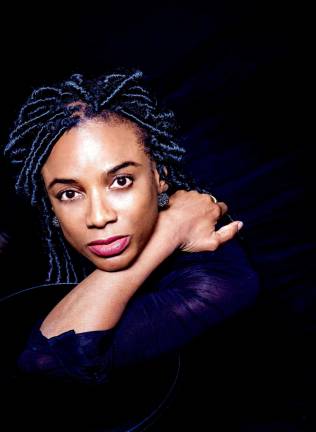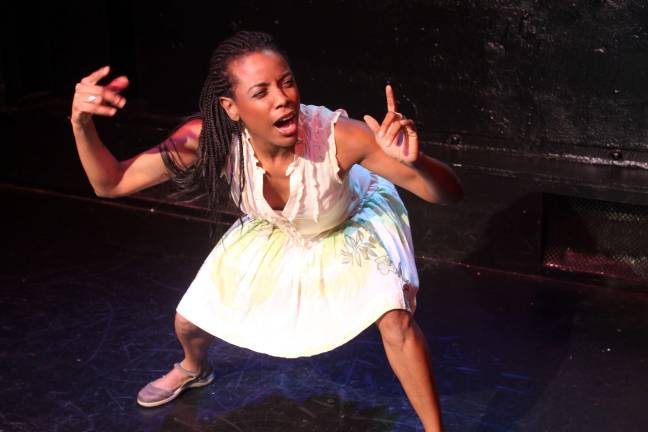Bright and precious


A Theatrical Retrospective on Coming to America
“Even in America, I can tell a Guyanese from the gold ring on their hand. It’s very distinct gold,” Ingrid Griffith, the woman behind the one-woman play “Demerara Gold,” said. “Everybody in Guyana, whether you’re rich or poor, has a ring on their hand, because it shows that we are going to get out of this.”
When it came to naming her two-act show, which recounts her immigrant story through 18 different characters, she used the unique gold from the Demerara River in her native Guyana as a metaphor to represent the uniqueness inside each of us.
The plot centers around her young self being left with her two grandmothers and sister in the Caribbean when her parents immigrate to America. When she finally secures a visa and joins them in the United States, things are not what she expected as she assimilates to American culture.
The Upper West Side resident, who has been in New York since 1984, now looks to the Hudson River that runs through her adopted home as a replacement for the one that represents her childhood. “Demerara is much more vast, but the Hudson is like the water still in me.”
Griffith, who has done the show 75 times to date, will be performing it at Goddard Riverside’s Bernie Wohl Center on December 8.
Give us a synopsis of your show. It’s a coming-of-age story of a 7-year-old girl who is left behind in the Caribbean as she watches her parents leave without her to come to the U.S. The story starts there, when she realizes she’s not going. When they tell her there’s no visa for her, just for them. And then there’s a scene with them leaving her behind in the care of her two grandmothers. For about 25 minutes, you see the child between her two grandmothers. One is a very strict ex-teacher, who doesn’t leave her house anymore. The other is a religious fanatic. It’s very humorous, about her growing up among her two grandmothers who are in two different worlds and her having to adjust as she waits for her parents either to return or for a visa for her to join them in the U.S.
This project started out as a memoir. What were the challenges you faced while writing it?I’m an actor and got my master’s in creative writing, so when I got out of the program, I thought, “Maybe I should try a one-woman show with that story.” Six months into writing, I looked into various people in the city and found Matt Hoverman, who is really amazing who coaches solo show workshops. I did the first part, which took six months, and then had to write the second part, about when she comes to the U.S. The story continues when she does get the visa. I thought that would have been the end, but once I finished that, I realized I needed to tell about what life was like when I did finally rejoin my parents. So that took another six months to write and then I workshopped it for another six months. The process was about two years, with workshops and rewriting, and performing it at small venues.
When you first came here, you lived on Long Island, and attended a school that was mostly white. Was America like you had envisioned it? I lived in Wheatley Heights, New York, right outside of Wyandanch. I never even thought about that I would be in a school that would be mostly white. Guyana is the land of five races, so it’s mostly Indians from East India, blacks from Africa, Portuguese from Madeira, Chinese and indentured people. As a 12-year-old, I just wanted to be with my parents. So when I came, there were a lot of new awakenings and things that I never even considered. Like the fact that snow would be really uncomfortable. I thought it would be magical and I’d be outdoors all day in it. There were a lot of things that, as a kid, I never thought of, because we never experienced them in Guyana.
In this show you play 18 characters. How do you keep them all straight? I just have been doing it for a while. I know these characters, in the sense that I grew up with them — my mom, dad, family members. So I know exactly who I’m playing because I know them well. I think that just to keep them straight in the piece, I’ve written and rewritten the story 500,000 times, so know it inside out. When I just started performing it, I used to be afraid that I wouldn’t remember where I was next. Not necessarily the characters, but, “Where am I going next?” Once, when my mom was in the audience, I think it was because she was there, it felt like 30 minutes of not knowing where I was. But when I told everyone I was so sorry, they said, “What are you talking about?” It seems much longer than it is. But you’re out there on your own, so you just jump in and figure it out.
What do you want audiences to take away from your story?First, the fact that it’s such an empowering genre. The one-woman, one-man format is really empowering to not only the actor, but the audience, because I can tell my story and make it work and don’t have to count on a budget, producer, agent, or find the right cast and all that. And I think the audience feels it. When they see a woman on stage and then the story begins, they have to be swept into it, and they are. I speak from the child’s point of view and you don’t really hear that when it comes to an immigrant experience, you always hear the adults. The takeaway is our experiences are so similar. People come and tell me, “I know this story.” Their parents are from Ireland or Russia and they connect because the story is so universal in a very profound way.